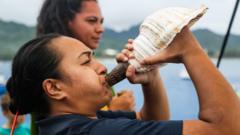The Cook Islands, known for its breathtaking turquoise waters and delicate ecosystem, now stands at a pivotal moment as it considers deep-sea mining for polymetallic nodules. These valuable minerals, packed with cobalt, nickel, and manganese, are seen as vital resources for modern technology, particularly renewable energy solutions like electric vehicle batteries. However, the initiative, led by Prime Minister Mark Brown, has garnered significant opposition from environmental activists and community members who foresee a potential ecological disaster in the pursuit of wealth.
Jean Mason, curator at the Cook Islands Library and Museum, breaks the ice with humor as she introduces the black, knobbly nodules that could hold the key to the islands’ economic future. "They look like chocolate truffles, just don't eat them," she jokes, highlighting the curiosity and value of these rock formations that have lain unmoved on the seabed for millennia.
Although the nodules have been recognized since the 19th century, they gained traction in the 1960s when geologist John L. Mero argued for their potential in meeting global mineral needs. With the Cook Islands hit hard by the combined effects of climate change and tourism downturns during the pandemic, the government issued exploration licenses to companies eager to tap into the estimated 12 billion wet tonnes of polymetallic nodules in their exclusive economic zone.
Despite proponents asserting that seabed mining is a less invasive alternative to terrestrial operations, critics remain concerned about the unknown impacts on marine life and ecosystems. "Before we rush into mining, we need more robust research on its environmental effects," asserts Alanah Matamaru Smith, an environmental advocate. She echoes the sentiments of many who participate in a traditional chant, "Protect our ocean," emphasizing the call for caution.
Some stakeholders argue that delaying mining could jeopardize much-needed economic support for the island’s future. Hans Smit, head of Moana Minerals, who believes in harnessing the ocean's resources responsibly, contends that a “zero-risk” approach is unrealistic. He acknowledges that maintaining their lifestyle comes with certain costs, thus justifying the pursuit of deep-sea minerals.
Rima Brown, a local representative, passionately defends her community's right to exploit its resources, questioning why wealthier nations can exploit the environment while lecturing smaller countries against similar actions.
Yet dissent echoes through the islands. June Hosking, an activist from Mauke, emphasizes that meaningful conversations on the consequences of mining often get stifled in her close-knit community. "You can't drive very far in neutral," she insists, calling for more decisive action towards environmental stewardship and accountability.
The government envisions a prosperous future driven by mining revenues, which could ultimately finance education, healthcare, and secure local livelihoods—critical considerations for a nation wrestling with climate-induced challenges. But as this narrative unfolds, the balance between economic opportunity and ecological responsibility remains tenuous, leaving residents to ponder: will the benefits of seabed mining outweigh the potential risks?
This ongoing debate draws international attention as discussions about the long-term sustainability of deep-sea mining intensify globally. The Cook Islands, often dubbed "large ocean states," now finds itself navigating one of the most consequential decisions in its history.




















